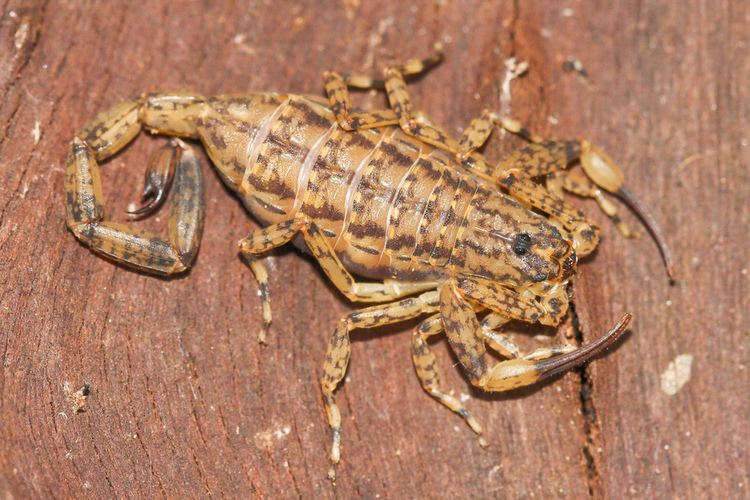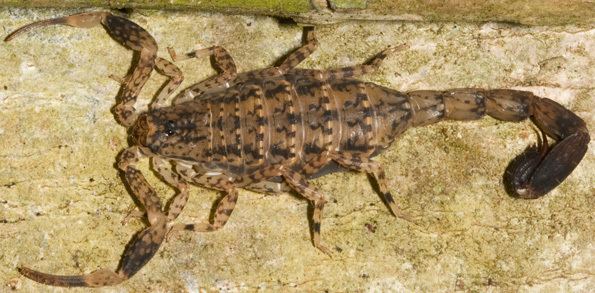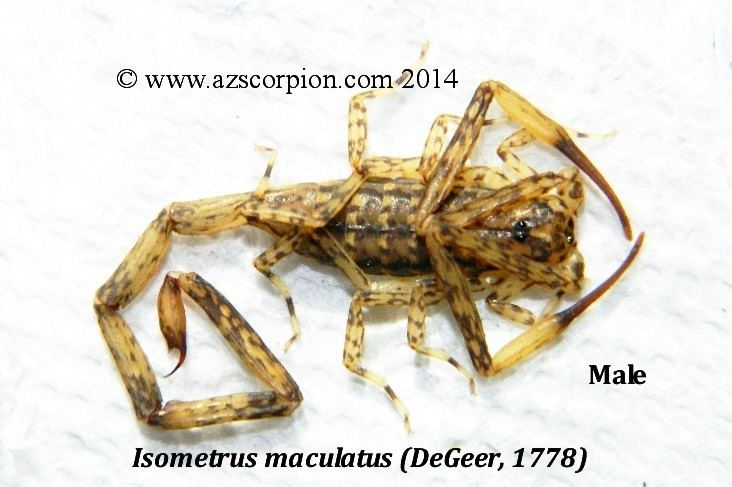 | ||
Similar | ||
Isometrus maculatus feeding
Isometrus maculatus is a species of scorpion in the Buthidae family, commonly called in English the lesser brown scorpion. It is a native species of Asia which now has an extended pantropical range. Its spread is thought to have been facilitated by human activity, and it is often found near human habitation in the areas where it has been introduced. Information on the effects it may have on native species where it has been introduced is scarce, but it is believed they hail from Australia. It has been introduced to the islands of Hawaii, where it is a potential predator and a threat to some native cave dwelling arthropods.
Contents
- Isometrus maculatus feeding
- Isometrus maculatus communal lesser brown scorpion
- Taxonomy and Nomenclature
- Description
- Distribution
- References
Isometrus maculatus communal lesser brown scorpion
Taxonomy and Nomenclature

There is some confusion over whether Scorpio europaeus Linneaus, 1758 is a synonym of Isometrus maculatus De Geer 1778, with the original type specimen for S. europaeus being lost (Fet et al., 2002).
Description

I. maculatus is 45-60 mm from the anterior carapace margin to the tip of the aculeus, and is a uniformly mottled, pale yellowy-brown colour over the abdomen, pedipalps and legs. Marked adult sexual dimorphism is displayed in the species, with male pedipalpal and metasomal segments being much longer than those of females (Gerlach and Marusik, 2010). It has enlarged pedipalps appearing clawlike, the true jaws are small and partly hidden from the top by the carapace, and it has four pairs of terminally clawed legs (Yates, 1993). I. maculatus fluoresce under ultraviolet light, except when emerging from an old exoskeleton. Presumably this prevents detection by some predators when they are at their most vulnerable during a molt (Daintree Forest, 2016). Scorpions may require 5-7 instars to reach maturity, and fluorescence increases in intensity with each successive instar (Daintree Forest, 2016).
Distribution
I. maculatus is probably native to Sri Lanka and Philippines as is found inland there under natural conditions. Human activity has potentially allowed it to spread and it is thought to be the most widely distributed scorpion in the world (Lourenço and Cloudsley-Thompson, 2012). It is distributed in tropical areas worldwide (Yates, 1993). The species is mostly absent from Europe, although it is present on the Spanish mainland and Alboran (Fauna Europaea, 2013). It is also present in the following regions: Afro-tropical, Australia, Nearctic, Neotropical and Oriental (Fauna Europaea, 2013). I. maculatus is reported on the Hawaiian Islands of Oahu, Maui and Hawaii (Yates, 1993). It has also been introduced to Kauai in Hawaii where it is inhabiting the same caves as endemic amphipods, upon which it most likely preys (US Fish and Wildlife Service, 2006).
www.cabi.org/ISC/datasheet/78223


